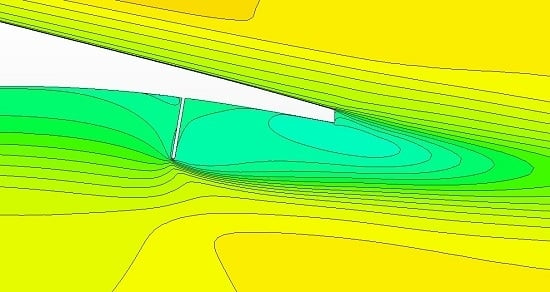Microtab Design and Implementation on a 5 MW Wind Turbine
Abstract
:1. Introduction
2. Parametric Study Based on CFD Calculations
2.1. Numerical Setup
2.2. Microtab Lay-Out
2.3. Computational Results
3. Wind Speed Model
- Mean wind speeds in the hub: 5 and 10 m/s;
- Spectral model: IECKAI (B); and
- Hub height: 90 m.
4. Methodology
- First of all, BEM based computations were carried out in order to characterize the dynamical behavior of the NREL 5 MW wind turbine, including Prandtl’s tip loss factor and Glauert’s correction. The BEM solver was developed and programmed by the authors of the current study based on the numerical iterative approach of Hansen [41]. All the necessary equations were derived and computed based on the steps proposed by the classical blade element momentum method. The usual basic steps for BEM calculations was followed; this is a short schedule:
- Initialization by guessing values of a and a’ values, axial and tangential induction factors, respectively.
- Calculate the flow angle Φ.
- Calculate the local angle of attack α.
- Read off CL (α) and CD (α).
- Compute the normal Cn and tangential Ct load coefficients.
- Re-calculate a and a’.
- State a tolerance for a and a’ and if it has changed more than that tolerance, go to (b) or else finish.
- Compute the local loads.
- Following the specifications of the utility scale multi megawatt wind turbine NREL 5 MW baseline described in [22], all the wind turbine rotor properties were introduced as input characteristics. The polar curves of the airfoil with the MT were taken from best case found in Section 2, which is the DU91W(2)250MT9520 with the MT position from the leading edge at 95% of c and the MT height of 2% of c.
- The surfaces of power coefficient Cp were calculated for all cases of the present study according to the matrix distribution described in Table 2.
- Once the Cp surfaces have been generated, BEM based computations are run for the four cases and the power curve vs. wind speed is calculated to compare the power curve of the clean turbine with the curve of the turbine with the MTs implemented.
- Afterwards, the wind speed realizations explained in Section 3 are introduced to calculate the average wind turbine power output for all cases.
- The results of the average wind turbine power output for all cases and at two different wind speed realizations are compared with the mean power output of the clean wind turbine, the one without any flow control device implemented.
5. Results from BEM Computations
- ▪
- vj: is the wind speed according to the realizations shown in Figure 11.
- ▪
- Nbins: number of bins per data.
- ▪
- P(vj): power at the wind speed vj.
- ▪
- N(vj): number of data at the wind speed vj.
6. Conclusions
Acknowledgments
Author Contributions
Conflicts of Interest
References
- Bouzelata, Y.; Altin, N.; Chenni, R.; Kurt, E.; Chenni, R.; Kurt, E. Exploration of optimal design and performance of a hybrid wind-solar energy system. Int. J. Hydrogen Energy 2016, 41, 12497–12511. [Google Scholar] [CrossRef]
- Novosel, T.; Cosic, B.; Puksec, T.; Krajacic, G.; Duic, N.; Mathiesen, B.V.; Lund, H.; Mustafa, M. Integration of renewables and reverse osmosis desalination—Case study for the jordanian energy system with a high share of wind and photovoltaics. Energy 2015, 92, 270–278. [Google Scholar] [CrossRef]
- Komusanac, I.; Cosic, B.; Duic, N. Impact of high penetration of wind and solar PV generation on the country power system load: The case study of croatia. Appl. Energy 2016, 184, 1470–1482. [Google Scholar] [CrossRef]
- Jaume, A.M.; Wild, J. Aerodynamic design and optimization of a high-lift device for a wind turbine airfoil. In New Results in Numerical and Experimental Fluid Mechanics X; German Aerospace Aerodynamics Association: Munich, Germany, 2016; Volume 132, pp. 859–869. [Google Scholar]
- Vaz, J.R.P.; Wood, D.H. Aerodynamic optimization of the blades of diffuser-augmented wind turbines. Energy Convers. Manag. 2016, 123, 35–45. [Google Scholar] [CrossRef]
- Houghton, T.; Bell, K.R.W.; Doquet, M. Offshore transmission for wind: Comparing the economic benefits of different offshore network configurations. Renew. Energy 2016, 94, 268–279. [Google Scholar] [CrossRef]
- Johnson, S.J.; van Dam, C.P. Active Load Control Techniques for Wind Turbines; Technical Report SAND2008-4809; Sandia National Laboratories: Livermore, CA, USA, 2008. [Google Scholar]
- Chow, R.; van Dam, C.P. On the temporal response of active load control devices. Wind Energy 2010, 13, 135–149. [Google Scholar] [CrossRef]
- Taylor, H.D. Summary Report on Vortex Generators; Research Department Report No. R-05280-9; United Aircraft Corporation: East Hartford, CT, USA, 1950. [Google Scholar]
- Liu, Y.; Sun, J.; Tang, Y.M.; Lu, L.P. Effect of slot at blade root on compressor cascade performance under different aerodynamic parameters. Appl. Sci. (Basel) 2016, 6, 421. [Google Scholar] [CrossRef]
- Liu, Y.; Sun, J.; Lu, L. Corner separation control by boundary layer suction applied to a highly loaded axial compressor cascade. Energies 2014, 7, 7994–8007. [Google Scholar] [CrossRef]
- Wood, R.M. Discussion of Aerodynamic Control Effectors Concepts (ACEs) for Future Unmanned Air Vehicles (UAVs). Presented at AIAA’s 1st Conference and Workshop on Unmanned Aerospace Vehicles, Systems, Technologies, and Operations, Portsmouth, VA, USA, 20–22 May 2002. AIAA Paper No. 2002-3494. [Google Scholar]
- Shires, A.; Kourkoulis, V. Application of circulation controlled blades for vertical axis wind turbines. Energies 2013, 6, 3744–3763. [Google Scholar] [CrossRef]
- Xu, H.; Qiao, C.; Ye, Z. Dynamic stall control on the wind turbine airfoil via a co-flow jet. Energies 2016, 9, 429. [Google Scholar] [CrossRef]
- Aramendia-Iradi, I.; Fernandez-Gamiz, U.; Sancho-Saiz, J.; Zulueta-Guerrero, E. State of the art of active and passive flow control devices for wind turbines. DYNA 2016, 91, 512–516. [Google Scholar] [CrossRef]
- Becker, R.; Garwon, M.; Guknecht, C.; Barwolff, G.; King, R. Robust control of separated shear flows in simulation and experiment. J. Process Control 2005, 15, 691–700. [Google Scholar] [CrossRef]
- Macquart, T.; Maheri, A. Integrated aeroelastic and control analysis of wind turbine blades equipped with microtabs. Renew. Energy 2015, 75, 102–114. [Google Scholar] [CrossRef]
- Van Dam, C.; Nakafuji, D.Y.; Bauer, C.; Standish, K.; Chao, D. Computational design and analysis of a microtab based aerodynamic loads control system for lifting surfaces. In Proceedings of the MEMS Components and Applications for Industry, Automobiles, Aerospace, and Communication II, San Jose, CA, USA, 25 January 2003; Volume 4981, pp. 28–39. [Google Scholar]
- Baker, J.P.; Standish, K.J.; van Dam, C.P. Two-dimensional wind tunnel and computational investigation of a microtab modified airfoil. J. Aircr. 2007, 44, 563–572. [Google Scholar] [CrossRef]
- Van Dam, C.P.; van Dam, C.P.; Chow, R.; Zayas, J.R.; Berg, D.E. Computational investigations of small deploying tabs and flaps for aerodynamic load control. Sci. Mak. Torque Wind 2007, 75, 012027. [Google Scholar]
- Yen, D.T.; Van Dam, C.P.; Bräuchle, F.; Smith, R.L.; Collins, S.D. Active Load Control and Lift Enhancement Using MEM Translational Tabs. In Proceedings of the AIAA 2000-2242, Fluids 2000 Conference and Exhibit, Fluid Dynamics and Co-located Conferences, Denver, CO, USA, 19–22 June 2000. [Google Scholar]
- Jonkman, J.; Butterfield, S.; Musial, W.; Scott, G. Definition of a 5 MW Reference Wind Turbine for Offshore System Development; Technical Report NREL/TP-500-38060; National Renewable Energy Laboratory: Golden, CO, USA, 2009. [Google Scholar]
- Menter, F.R. Zonal two equation k-w turbulence models for aerodynamic flows. In Proceedings of the 23rd Fluid Dynamics, Plasmadynamics, and Lasers Conference, Fluid Dynamics and Co-located Conferences, Orlando, FL, USA, 6–9 July 1993; American Institute of Aeronautics and Astronautics: Orlando, FL, USA, 1993. [Google Scholar]
- Kral, L. Recent experience with different turbulence models applied to the calculation of flow over aircraft components. Prog. Aerosp. Sci. 1998, 34, 481–541. [Google Scholar] [CrossRef]
- Gatski, T.B. Turbulence Modeling for Aeronautical Flows, vol. VKI Lecture Series: CFD-Based Aircraft Drag Prediction and Reduction; von Karman Institute for Fluid Dynamics: Brussels, Belgium, 2003. [Google Scholar]
- Mayda, E.A.; van Dam, C.P.; Nakafuji, D. Computational Investigation of Finite Width Microtabs for Aerodynamic Load Control. In Proceedings of the 43rd AIAA Aerospace Sciences Meeting and Exhibit Anonymous, Reno, Nevada, 10–13 January 2005. [Google Scholar]
- Sørensen, N.N.; Mendez, B.; Muñoz, A.; Sieros, G.; Jost, E.; Lutz, T.; Papadakis, G.; Voutsinas, S.; Barakos, G.N.; Colonia, S.; et al. CFD code comparison for 2D airfoil flows. J. Phys. Conf. Ser. 2016, 753, 082019. [Google Scholar] [CrossRef]
- Vinokur, M. On one-dimensional stretching functions for finite-difference calculations. J. Comput. Phys. 1983, 50, 215–234. [Google Scholar] [CrossRef]
- Thompson, J.F.; Warsi, Z.U.A.; Mastin, C.W. Numerical Grid Generation; Elsevier: North-Holland, NY, USA, 1985. [Google Scholar]
- Kooijman, H.J.T.; Lindenburg, C.; Winkelaar, D.; van der Hooft, E.L. DOWEC 6 MW Pre-Design: Aero-Elastic Modeling of the DOWEC 6 MW Pre-Design in PHATAS; Technical Report ECN-CX--01-135, DOWEC 10046_009; Energy Research Center of the Netherlands: Petten, The Netherlands, 2003. [Google Scholar]
- Lindenburg, C. Aeroelastic Modeling of the LMH64-5 Blade; Technical Report DOWEC-02-KL-083/0, DOWEC 10083_001; Energy Research Center of the Netherlands: Petten, The Netherlands, 2002. [Google Scholar]
- Standish, K.; van Dam, C. Computational analysis of a microtab-based aerodynamic load control system for rotor blades. J. Am. Helicopter Soc. 2005, 50, 249–258. [Google Scholar] [CrossRef]
- Ayerdi-Zaton, J.; Fernandez-Gamiz, U.; Zulueta, E.; Lopez-Guede, J.M.; Ramos, J.A. Computational study of a microtab deployed on a DU airfoil. In Proceedings of the European Conference on Renewable Energy Systems ECRES, Istanbul, Turkey, 28–31 August 2016. [Google Scholar]
- Zahle, F.; Sørensen, N.N.; Graham, J.M.R. Computational study of the risø B1-24 wind turbine profile fitted with gurney flaps. In Proceedings of the EWEA Special Topic Conference, London, UK, 22–25 November 2004. [Google Scholar]
- Kelley, N.; Jonkman, B. NWTC Computer-Aided Engineering Tools (TurbSim). 2012. Available online: http://wind.nrel.gov/designcodes/preprocessors/turbsim/ (accessed on 17 June 2016).
- Veers, P.S. Three-Dimensional Wind Simulation; Technical Report SAND88-0152; Sandia National Laboratories: Albuquerque, NM, USA, 1988. [Google Scholar]
- IEC 61400-1. Wind Turbine Generator Systems-Part 1: Safety Requirements, 2nd ed.; Technical Report; International Electrotechnical Commission: Geneva, Switzerland, 1999. [Google Scholar]
- IEC 61400-1. Wind Turbines-Part 1: Design Requirements, 3rd ed.; Technical Report; International Electrotechnical Commission: Geneva, Switzerland, 2005. [Google Scholar]
- Nijssen, R. WMC5 MW Laminate Lay-Out of Reference Blade for WP 3: Upwind WMC5 MW 374 Laminate Data, Review 1; Knowledge Centre Wind Turbine Materials and Constructions: Wieringerwerf, The Netherlands, 2007. [Google Scholar]
- Timmer, W.A.; van Rooij, R.P.J.O.M. Summary of the delft university wind turbine dedicated airfoils. J. Sol. Energy Eng. Trans. ASME 2003, 125, 488–496. [Google Scholar] [CrossRef]
- Hansen, M.O.L. Aerodynamics of Wind Turbines; Earthscan Publications Ltd.: London, UK, 2015. [Google Scholar]

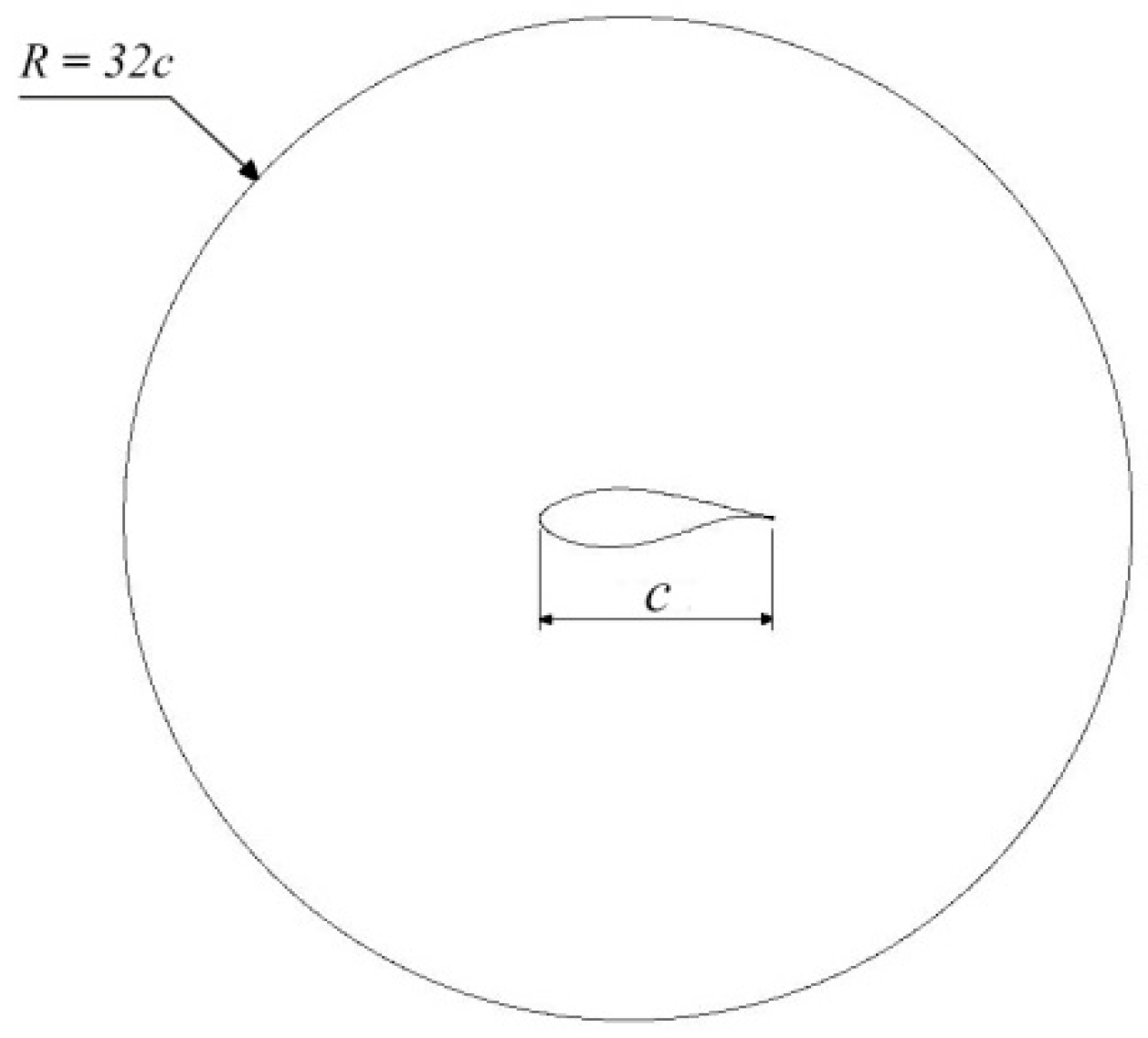

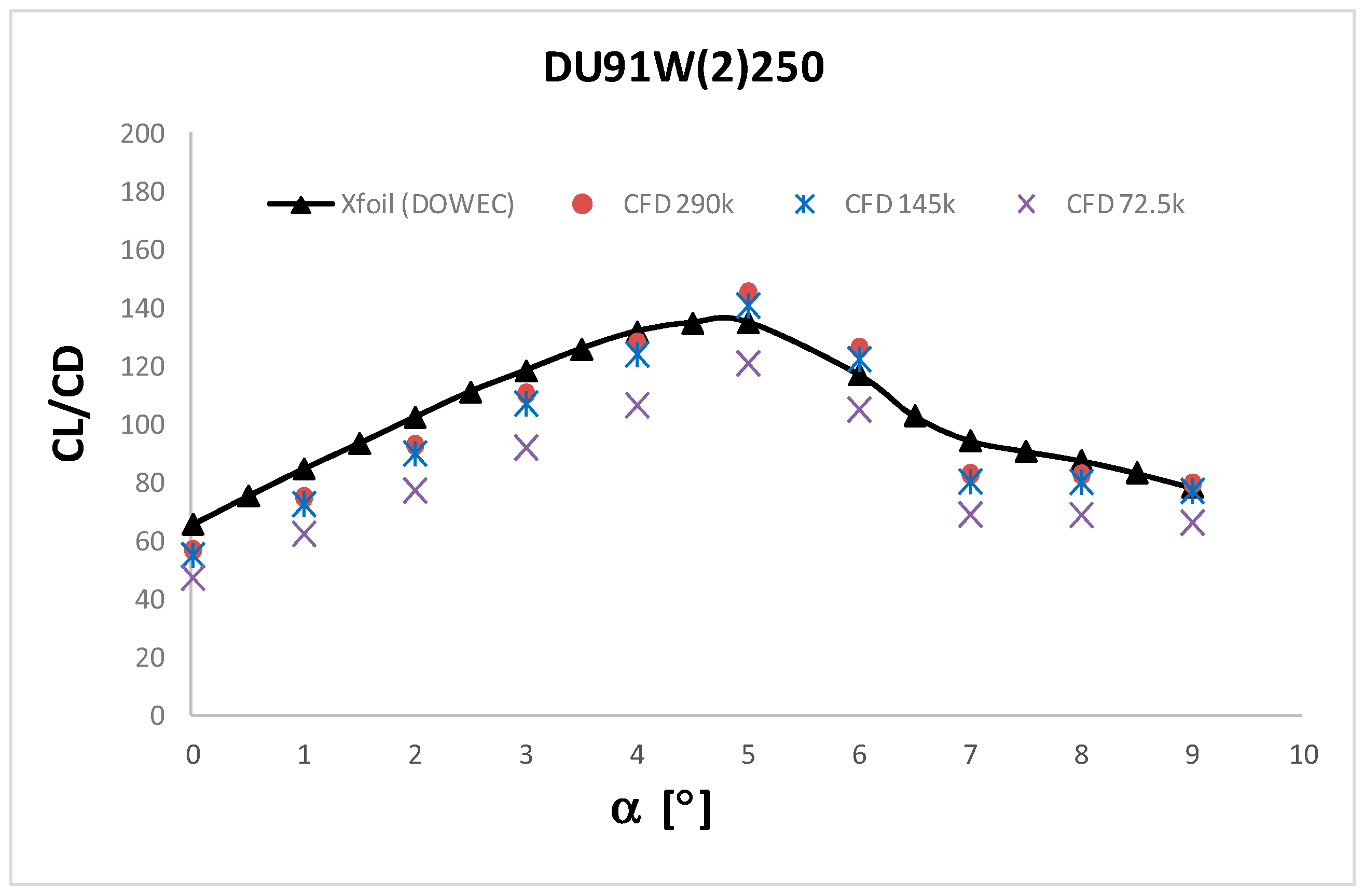
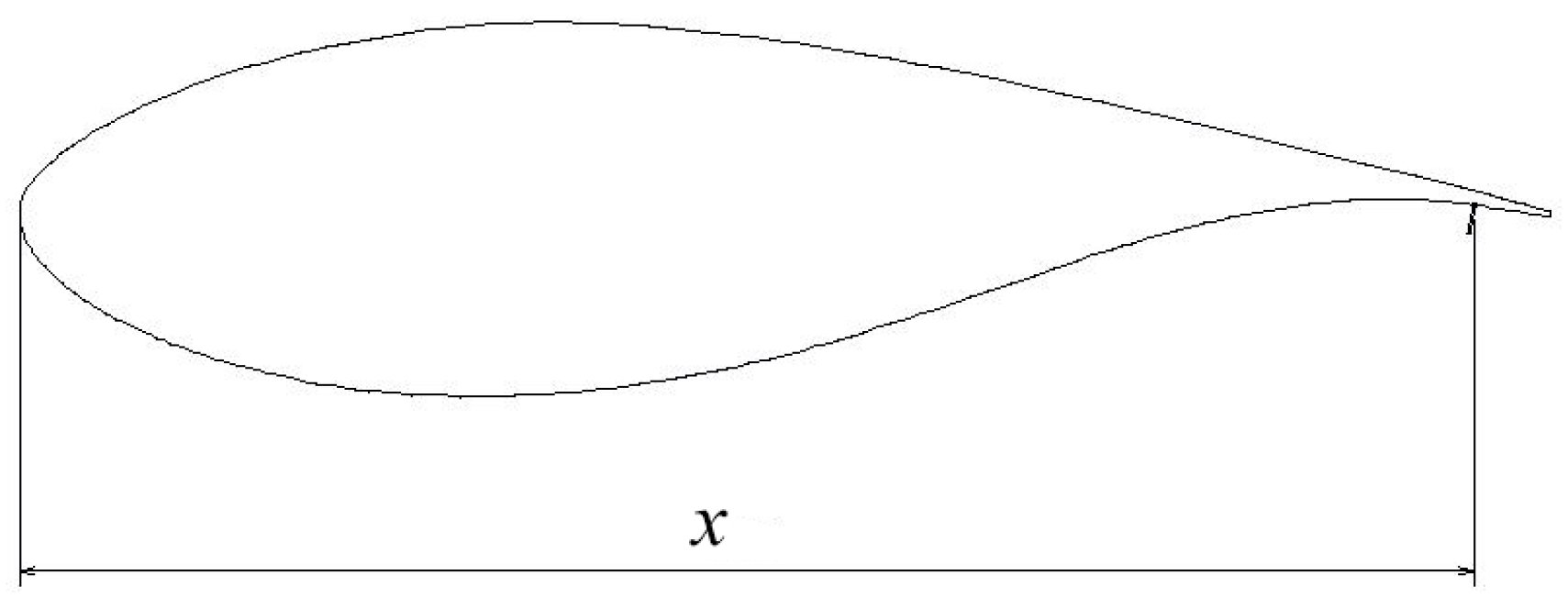



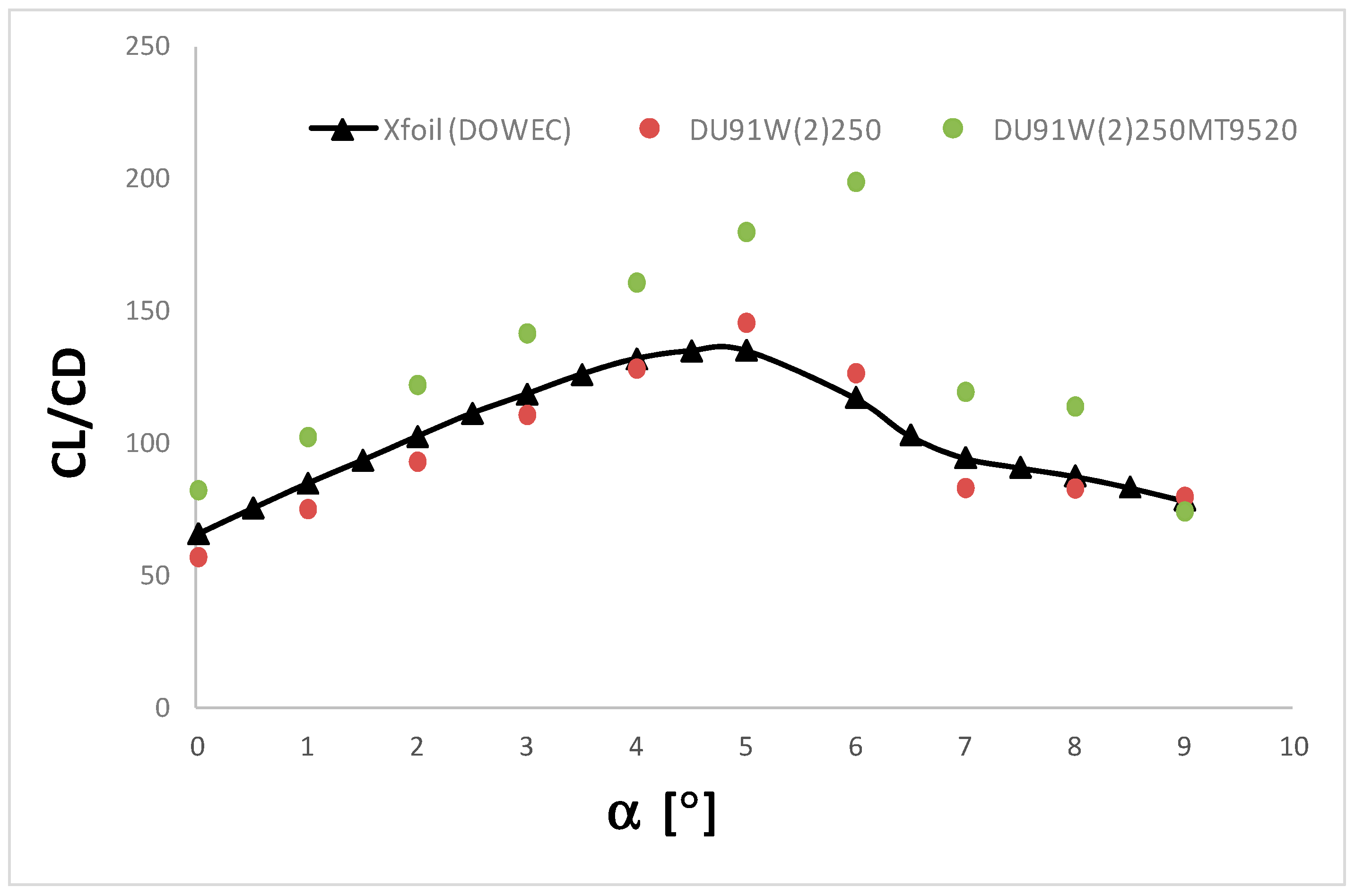
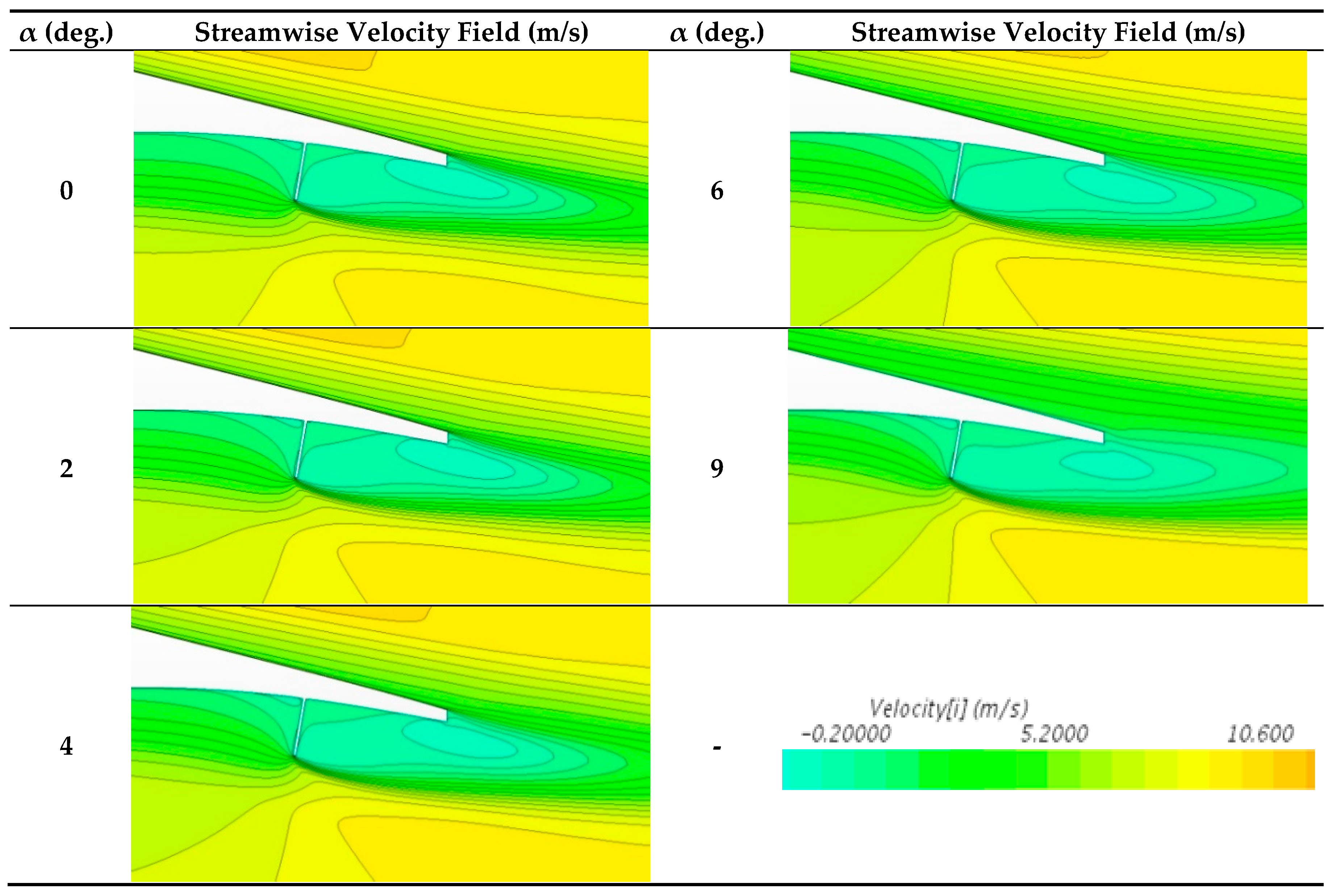

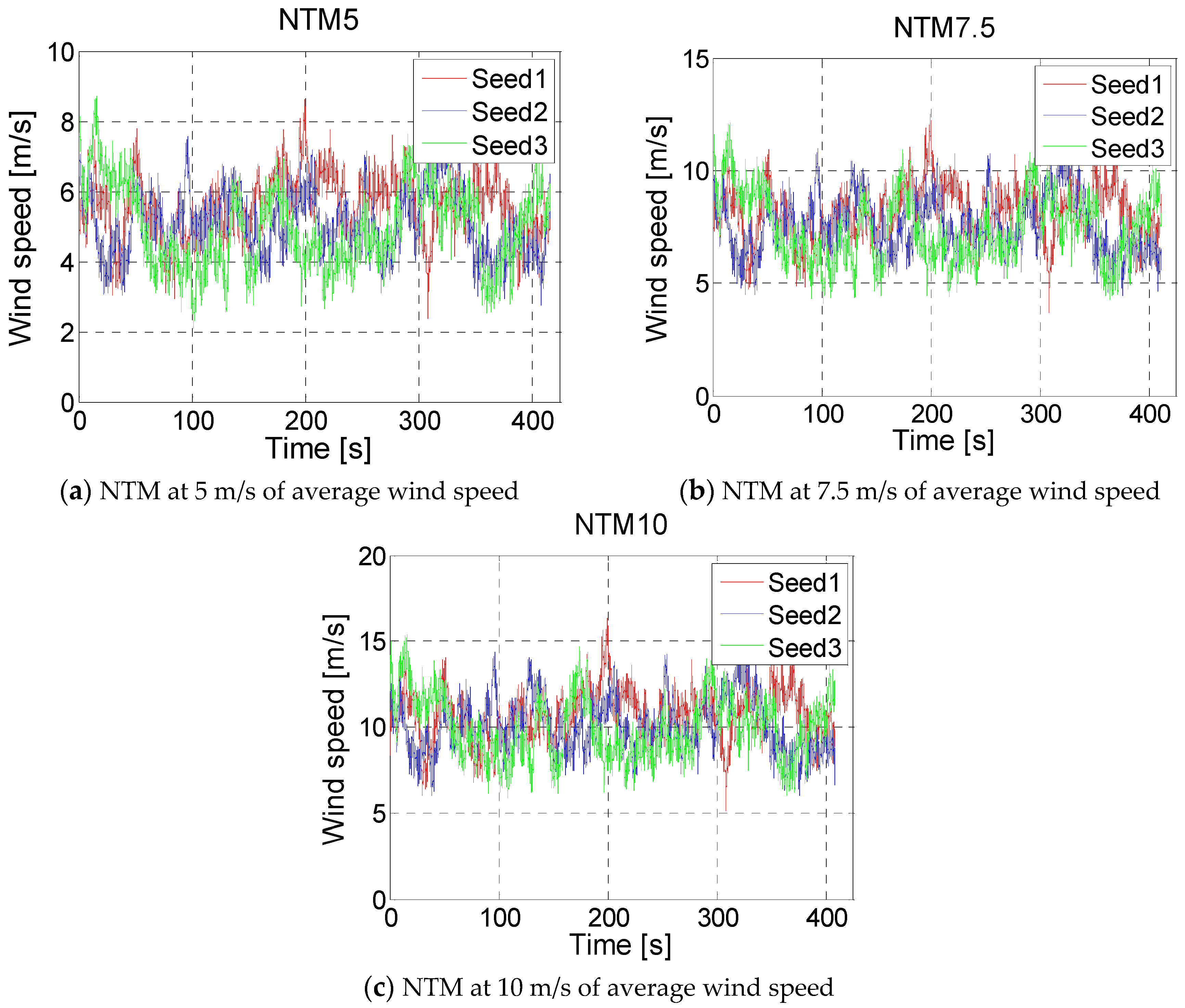
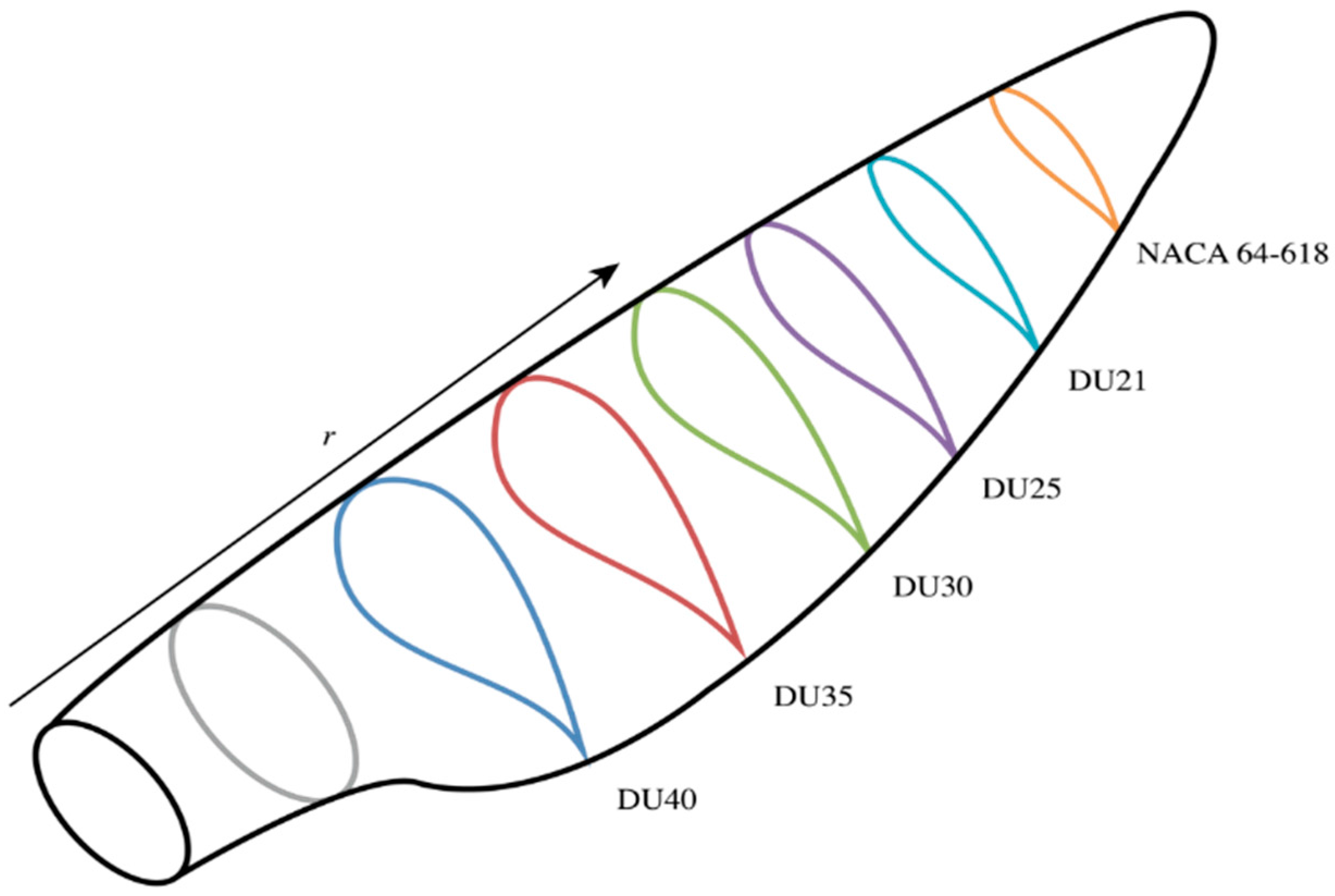
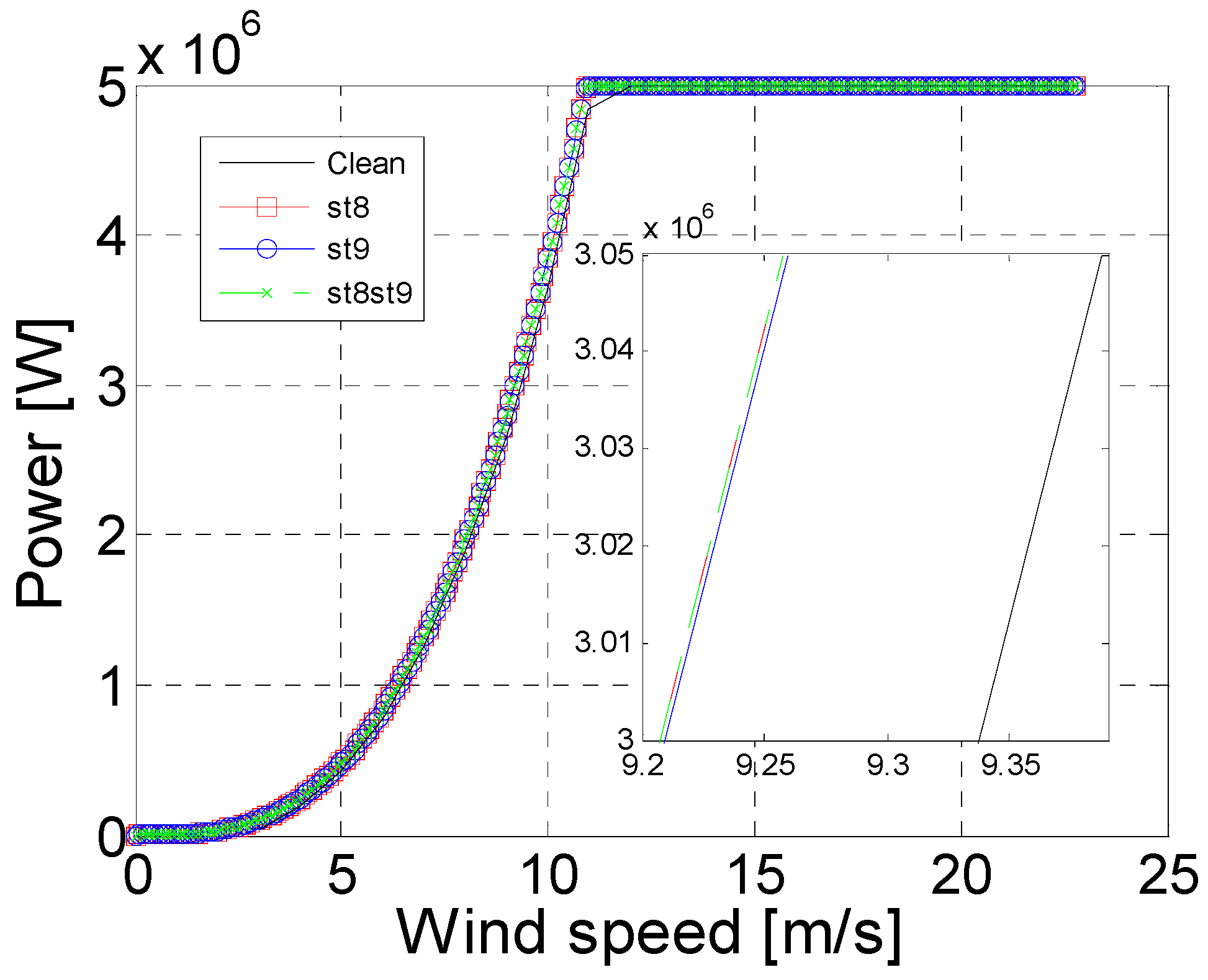
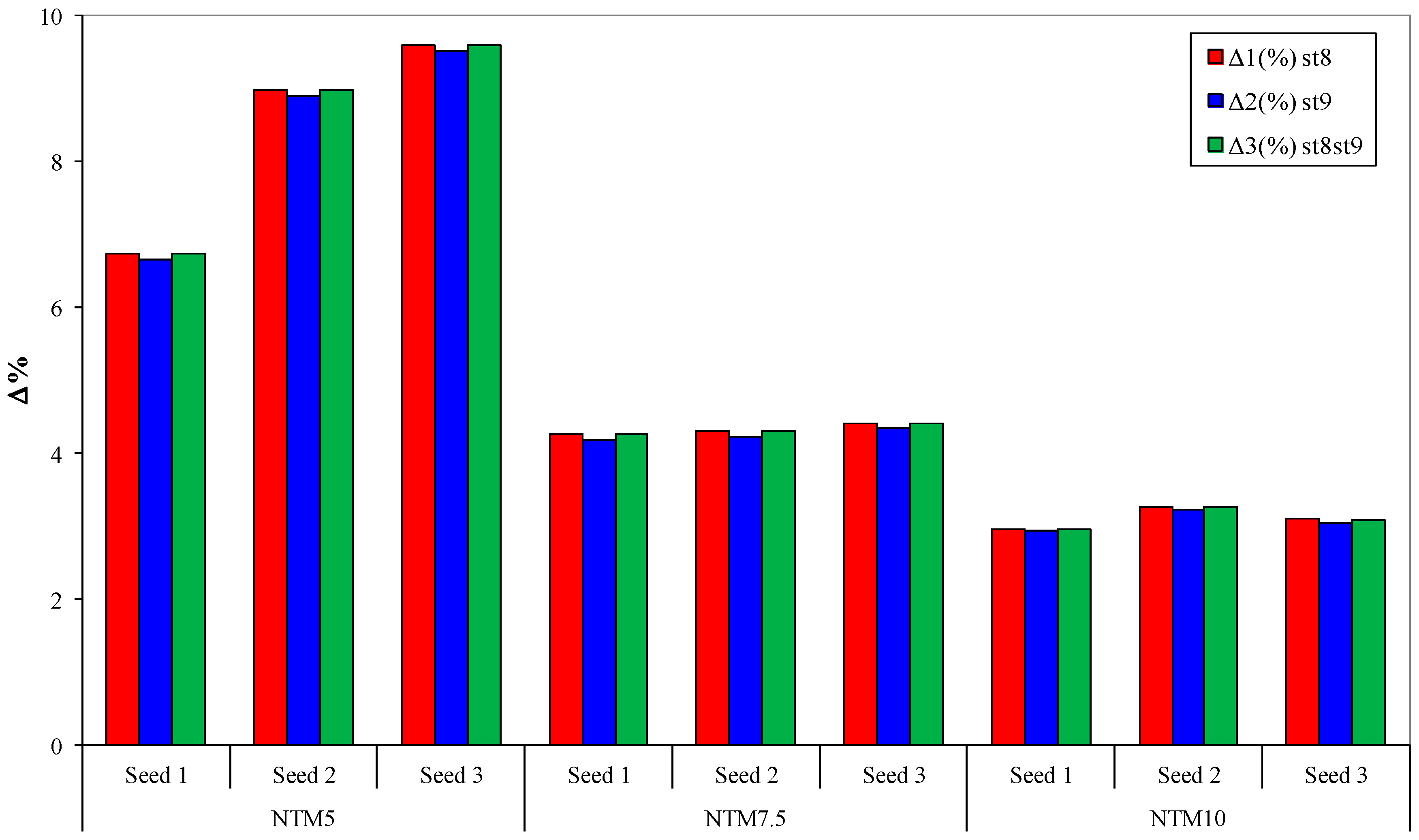
| Case Name | x (%c) | y (%c) |
|---|---|---|
| DU91W(2)250 | no MT | no MT |
| DU91W(2)250MT9310 | 93 | 1.0 |
| DU91W(2)250MT9315 | 93 | 1.5 |
| DU91W(2)250MT9320 | 93 | 2.0 |
| DU91W(2)250MT9410 | 94 | 1.0 |
| DU91W(2)250MT9415 | 94 | 1.5 |
| DU91W(2)250MT9420 | 94 | 2.0 |
| DU91W(2)250MT9510 | 95 | 1.0 |
| DU91W(2)250MT9515 | 95 | 1.5 |
| DU91W(2)250MT9520 | 95 | 2.0 |
| DU91W(2)250MT9610 | 96 | 1.0 |
| DU91W(2)250MT9615 | 96 | 1.5 |
| DU91W(2)250MT9620 | 96 | 2.0 |
| TEST CASES | st8 | st9 |
|---|---|---|
| DU91W(2)250 | no MT | no MT |
| DU91W(2)250MT9520st8 | X | - |
| DU91W(2)250MT9520st9 | - | X |
| DU91W(2)250MT9520st8st9 | X | X |
| Station | r (m) | Airfoil |
|---|---|---|
| 1 | 2.8667 | Cylinder1 |
| 2 | 5.6000 | Cylinder1 |
| 3 | 8.3333 | Cylinder2 |
| 4 | 11.7500 | DU40 |
| 5 | 15.8500 | DU35 |
| 6 | 19.9500 | DU35 |
| 7 | 24.0500 | DU30 |
| 8 | 28.1500 | DU25 |
| 9 | 32.2500 | DU25 |
| 10 | 36.3500 | DU20 |
| 11 | 40.4500 | DU20 |
| 12 | 44.5500 | NACA64XX |
| 13 | 48.6500 | NACA64XX |
| 14 | 52.7500 | NACA64XX |
| 15 | 56.1667 | NACA64XX |
| 16 | 58.9000 | NACA64XX |
| 17 | 61.6333 | NACA64XX |
| CLEAN (W) | st8 (W) | Δ1 (%) | st9 (W) | Δ2 (%) | st8st9 (W) | Δ3 (%) | ||
|---|---|---|---|---|---|---|---|---|
| NTM5 | Seed 1 | 639,653 | 682,736 | 6.735 | 682,247 | 6.659 | 682,731 | 6.734 |
| Seed 2 | 498,572 | 543,347 | 8.981 | 542,959 | 8.903 | 543,339 | 8.979 | |
| Seed 3 | 485,570 | 532,180 | 9.599 | 531,780 | 9.517 | 532,154 | 9.594 | |
| NTM7.5 | Seed 1 | 2,043,199 | 2,130,449 | 4.270 | 2,128,954 | 4.197 | 2,130,449 | 4.270 |
| Seed 2 | 1,712,749 | 1,786,646 | 4.315 | 1,785,376 | 4.240 | 1,786,641 | 4.314 | |
| Seed 3 | 1,665,902 | 1,739,621 | 4.425 | 1,738,406 | 4.352 | 1,739,603 | 4.424 | |
| NTM10 | Seed 1 | 4,053,501 | 4,174,148 | 2.976 | 4,172,666 | 2.940 | 4,174,110 | 2.975 |
| Seed 2 | 3,565,184 | 3,682,177 | 3.282 | 3,680,524 | 3.235 | 3,682,172 | 3.281 | |
| Seed 3 | 3,417,900 | 3,524,200 | 3.110 | 3,522,500 | 3.060 | 3,523,800 | 3.098 |
| Variable | Name | Units |
|---|---|---|
| Vo | wind speed | m/s |
| ai | axial induction factor | - |
| a'i | tangential induction factor | - |
| ri | airfoil spanwise position (radius) | m |
| w | rotor rotational speed | rad/s |
| ρ | air density | Kg/m3 |
| Φ | flow angle | rads |
| ci | airfoil chord length | m |
| dT | thrust on the annular element | N |
| dM | root bending moment | Nm |
| B | number of blades | - |
| R | rotor radius | m |
| CLEAN (N) | st8 (N) | Δ1 (%) | st9 (N) | Δ2 (%) | st8st9 (N) | Δ3 (%) | ||
|---|---|---|---|---|---|---|---|---|
| NTM5 | Seed 1 | 187,634 | 188,168 | 0.284 | 188,158 | 0.279 | 188,166 | 0.283 |
| Seed 2 | 160,211 | 160,670 | 0.287 | 160,662 | 0.282 | 160,661 | 0.281 | |
| Seed 3 | 155,155 | 155,599 | 0.286 | 155,594 | 0.283 | 155,590 | 0.280 | |
| NTM7.5 | Seed 1 | 398,168 | 399,301 | 0.285 | 399,283 | 0.280 | 399,299 | 0.284 |
| Seed 2 | 352,561 | 353,563 | 0.284 | 353,545 | 0.279 | 353,562 | 0.284 | |
| Seed 3 | 342,486 | 343,461 | 0.285 | 343,449 | 0.281 | 343,452 | 0.282 | |
| NTM10 | Seed 1 | 570,742 | 572,303 | 0.273 | 572,283 | 0.270 | 572,295 | 0.272 |
| Seed 2 | 534,179 | 535,603 | 0.267 | 535,584 | 0.263 | 535,595 | 0.265 | |
| Seed 3 | 511,960 | 513,324 | 0.266 | 513,302 | 0.262 | 513,307 | 0.263 |
| CLEAN (Nm) | st8 (Nm) | Δ1 (%) | st9 (Nm) | Δ2 (%) | st8st9 (Nm) | Δ3 (%) | ||
|---|---|---|---|---|---|---|---|---|
| NTM5 | Seed 1 | 8109216 | 8126789 | 0.217 | 8126853 | 0.218 | 8126886 | 0.218 |
| Seed 2 | 6924009 | 6939014 | 0.217 | 6939069 | 0.218 | 6939076 | 0.218 | |
| Seed 3 | 6705529 | 6720060 | 0.217 | 6720113 | 0.218 | 6720113 | 0.218 | |
| NTM7.5 | Seed 1 | 17207278 | 17244535 | 0.217 | 17244704 | 0.218 | 17244704 | 0.218 |
| Seed 2 | 15237018 | 15270036 | 0.217 | 15270173 | 0.218 | 15270173 | 0.218 | |
| Seed 3 | 14801073 | 14833130 | 0.217 | 14833251 | 0.217 | 14833310 | 0.218 | |
| NTM10 | Seed 1 | 24598692 | 24644696 | 0.187 | 24644937 | 0.188 | 24644937 | 0.188 |
| Seed 2 | 23036435 | 23079692 | 0.188 | 23079743 | 0.188 | 23079651 | 0.188 | |
| Seed 3 | 22072422 | 22113547 | 0.186 | 22113587 | 0.187 | 22113697 | 0.187 |
© 2017 by the authors. Licensee MDPI, Basel, Switzerland. This article is an open access article distributed under the terms and conditions of the Creative Commons Attribution (CC BY) license (http://creativecommons.org/licenses/by/4.0/).
Share and Cite
Fernandez-Gamiz, U.; Zulueta, E.; Boyano, A.; Ramos-Hernanz, J.A.; Lopez-Guede, J.M. Microtab Design and Implementation on a 5 MW Wind Turbine. Appl. Sci. 2017, 7, 536. https://doi.org/10.3390/app7060536
Fernandez-Gamiz U, Zulueta E, Boyano A, Ramos-Hernanz JA, Lopez-Guede JM. Microtab Design and Implementation on a 5 MW Wind Turbine. Applied Sciences. 2017; 7(6):536. https://doi.org/10.3390/app7060536
Chicago/Turabian StyleFernandez-Gamiz, Unai, Ekaitz Zulueta, Ana Boyano, Josean A. Ramos-Hernanz, and Jose Manuel Lopez-Guede. 2017. "Microtab Design and Implementation on a 5 MW Wind Turbine" Applied Sciences 7, no. 6: 536. https://doi.org/10.3390/app7060536






